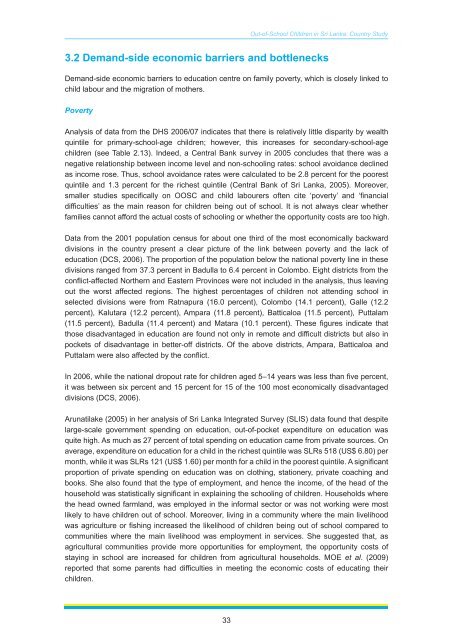Sri Lanka - Institut de statistique de l'Unesco
Sri Lanka - Institut de statistique de l'Unesco
Sri Lanka - Institut de statistique de l'Unesco
Create successful ePaper yourself
Turn your PDF publications into a flip-book with our unique Google optimized e-Paper software.
Out-of-School Children in <strong>Sri</strong> <strong>Lanka</strong>: Country Study<br />
3.2 Demand-si<strong>de</strong> economic barriers and bottlenecks<br />
Demand-si<strong>de</strong> economic barriers to education centre on family poverty, which is closely linked to<br />
child labour and the migration of mothers.<br />
Poverty<br />
Analysis of data from the DHS 2006/07 indicates that there is relatively little disparity by wealth<br />
quintile for primary-school-age children; however, this increases for secondary-school-age<br />
children (see Table 2.13). In<strong>de</strong>ed, a Central Bank survey in 2005 conclu<strong>de</strong>s that there was a<br />
negative relationship between income level and non-schooling rates: school avoidance <strong>de</strong>clined<br />
as income rose. Thus, school avoidance rates were calculated to be 2.8 percent for the poorest<br />
quintile and 1.3 percent for the richest quintile (Central Bank of <strong>Sri</strong> <strong>Lanka</strong>, 2005). Moreover,<br />
smaller studies specifically on OOSC and child labourers often cite ‘poverty’ and ‘financial<br />
difficulties’ as the main reason for children being out of school. It is not always clear whether<br />
families cannot afford the actual costs of schooling or whether the opportunity costs are too high.<br />
Data from the 2001 population census for about one third of the most economically backward<br />
divisions in the country present a clear picture of the link between poverty and the lack of<br />
education (DCS, 2006). The proportion of the population below the national poverty line in these<br />
divisions ranged from 37.3 percent in Badulla to 6.4 percent in Colombo. Eight districts from the<br />
conflict-affected Northern and Eastern Provinces were not inclu<strong>de</strong>d in the analysis, thus leaving<br />
out the worst affected regions. The highest percentages of children not attending school in<br />
selected divisions were from Ratnapura (16.0 percent), Colombo (14.1 percent), Galle (12.2<br />
percent), Kalutara (12.2 percent), Ampara (11.8 percent), Batticaloa (11.5 percent), Puttalam<br />
(11.5 percent), Badulla (11.4 percent) and Matara (10.1 percent). These figures indicate that<br />
those disadvantaged in education are found not only in remote and difficult districts but also in<br />
pockets of disadvantage in better-off districts. Of the above districts, Ampara, Batticaloa and<br />
Puttalam were also affected by the conflict.<br />
In 2006, while the national dropout rate for children aged 5–14 years was less than five percent,<br />
it was between six percent and 15 percent for 15 of the 100 most economically disadvantaged<br />
divisions (DCS, 2006).<br />
Arunatilake (2005) in her analysis of <strong>Sri</strong> <strong>Lanka</strong> Integrated Survey (SLIS) data found that <strong>de</strong>spite<br />
large-scale government spending on education, out-of-pocket expenditure on education was<br />
quite high. As much as 27 percent of total spending on education came from private sources. On<br />
average, expenditure on education for a child in the richest quintile was SLRs 518 (US$ 6.80) per<br />
month, while it was SLRs 121 (US$ 1.60) per month for a child in the poorest quintile. A significant<br />
proportion of private spending on education was on clothing, stationery, private coaching and<br />
books. She also found that the type of employment, and hence the income, of the head of the<br />
household was statistically significant in explaining the schooling of children. Households where<br />
the head owned farmland, was employed in the informal sector or was not working were most<br />
likely to have children out of school. Moreover, living in a community where the main livelihood<br />
was agriculture or fishing increased the likelihood of children being out of school compared to<br />
communities where the main livelihood was employment in services. She suggested that, as<br />
agricultural communities provi<strong>de</strong> more opportunities for employment, the opportunity costs of<br />
staying in school are increased for children from agricultural households. MOE et al. (2009)<br />
reported that some parents had difficulties in meeting the economic costs of educating their<br />
children.<br />
33

















